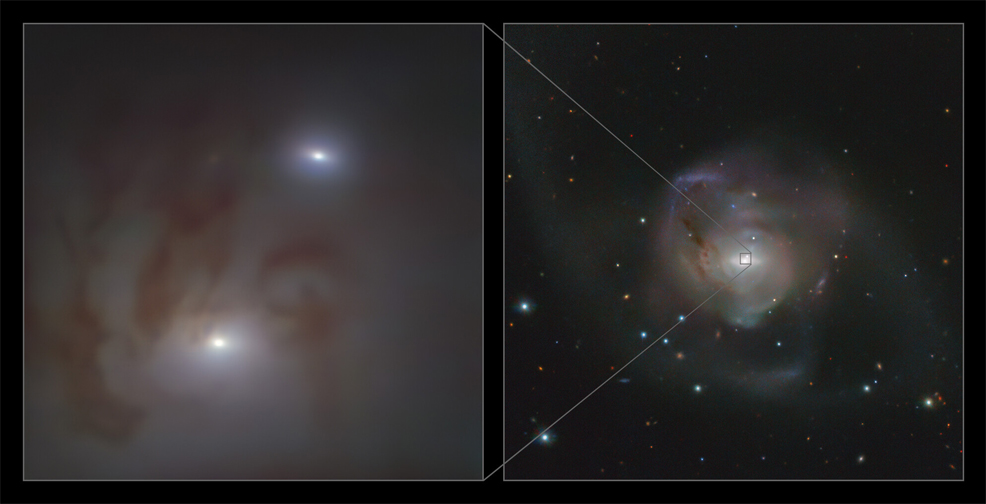
30th November 2021 Supermassive black holes predicted to collide Using the Very Large Telescope (VLT), astronomers at the European Southern Observatory (ESO) have spotted the closest pair of supermassive black holes ever observed. The two objects will eventually merge into one giant black hole, about 250 million years from now. The study also reveals that supermassive black holes may be 30% more numerous than previously thought.
Located in the galaxy NGC 7727 in the constellation Aquarius, the supermassive black hole pair seen here is about 89 million light years away from Earth. Although this may seem distant, it beats the previous record of 470 million light years by some margin, making the newfound pair the closest to us yet. Supermassive black holes lurk at the centre of large galaxies and when two such galaxies merge, the black holes end up on a collision course. The pair found in NGC 7727 beat the record for the smallest separation between supermassive black holes, as they are just 1,600 light years apart. For comparison, the Milky Way disc thickness is about 1,000 light years. "It is the first time we find two supermassive black holes that are this close to each other, less than half the separation of the previous record holder," explained Karina Voggel, astronomer at the Strasbourg Observatory in France and lead author of the study published today in Astronomy & Astrophysics. "The small separation and velocity of the two black holes indicate that they will merge into one monster black hole, probably within the next 250 million years," adds co-author Holger Baumgardt, Associate Professor in the Astrophysics Group at the University of Queensland, Australia.
Computer simulations of supermassive black holes prior to merging, shown at two different angles and speeds. Credit: NASA's Goddard Space Flight Center
Voggel and her team were able to determine the masses of the two objects by looking at how the gravitational pull of the black holes influences the motion of the stars around them. The bigger black hole, located at the core of NGC 7727, has a mass almost 154 million times that of the Sun, while its smaller companion is about 6.3 million solar masses. For comparison, the supermassive black hole at the centre of our own galaxy has a mass about 4.1 million times that of our Sun. This observation is the first time the masses have been measured in this way for a supermassive black hole pair. It was made possible thanks to the relatively close proximity of the system to Earth and the detailed observations the team obtained in Chile using the Multi-Unit Spectroscopic Explorer (MUSE), the latest of the second-generation instruments to be installed on Yepun (UT4), the fourth unit of the VLT. Measuring the masses with MUSE, and using additional data from the Hubble Space Telescope, allowed the team to confirm that the objects in NGC 7727 were indeed supermassive black holes. Astronomers had suspected that the galaxy hosted the two black holes. But they had not been able to confirm their presence until now, since we do not see large amounts of high-energy radiation coming from their immediate surroundings, which would otherwise give them away. "Our finding implies that there might be many more of these relics of galaxy mergers out there and they may contain many hidden massive black holes that still wait to be found," says Voggel. "It could increase the total number of supermassive black holes known in the local Universe by 30%." The search for similarly hidden supermassive black hole pairs is expected to make a great leap forward with ESO's Extremely Large Telescope (ELT), set to be constructed in Chile's Atacama Desert by 2025. The merging of supermassive pairs like these could explain how the most massive black holes in the Universe come to be. "This detection of a supermassive black hole pair is just the beginning," said co-author Steffen Mieske, an astronomer at ESO in Chile and Head of ESO Paranal Science Operations. "With the HARMONI instrument on the ELT we will be able to make detections like this considerably further than currently possible. ESO's ELT will be integral to understanding these objects."
Comments »
If you enjoyed this article, please consider sharing it:
|







